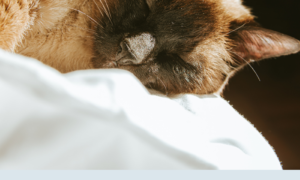Cats are so good at covering up health issues. Often, pet parents of a senior cat might not realize there’s a problem until it’s too late.
Dr. Cindy Houlihan, DVM, owner of The Cat Practice of Birmingham, MI, states that the age range where cats are generally classified as senior is between the ages of seven and 10.
Arthritis is a common condition in senior cats as they age. This often begins at the age of seven and is seen via an x-ray. The most common signs are:
- Limping
- Walking “hunched up”
- Problems getting in and out of the litter box
- Problems defecating because of difficulty squatting
Other common issues that generally arise as a cat ages are changes in the look, color and consistence, as well as size and quality of bowel movements and difficulty eating and drinking. Issues with eating and drinking may be alleviated by elevating food and water bowls.
Besides physical issues, cats often exhibit cognitive changes as they age. After 16 years of age, cats often stare off in the distance and look confused for a few moments. They might vocalize in confusion, have sight and hearing issues, have diminished hearing and eyesight and sleep more deeply.
Changes in senior cat behavior such as being cranky and irritable due to pain when being petted are common. In cases such as this, Houlihan recommends trying to help them by purchasing a heated bed, a litter box with lower sides and a step stool.
Photo Source: istockphoto.com 1001slide






